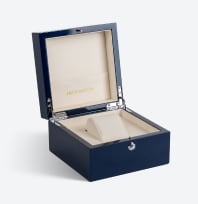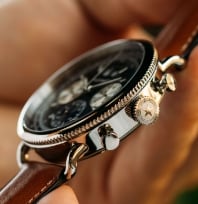The ability to jump right into the water, or not worrying about your watch getting wet while hand washing or showering is a massive sigh of relief for watch owners everywhere. What does water-resistant actually mean when it comes to watches, and how will you know what your watch can withstand?
What should you look for in water-resistance to know what your watch can do? There are a few different rating systems that will help you know exactly what your watch can withstand, this article will cover the three different ratings and standards.
- BARs or ATM/Meters
- ISO - International Organization of Standards
- IP Code or IP Rating
In this post, we'll be breaking down all the myths of water-resistant watches by uncovering the terminology and ratings so you can know precisely what to expect when buying your next watch.
Ratings
Water-resistance is the mark stamped on a watch back that indicates how much water pressure a watch can withstand. The tested pressure can be stated in BARs and ATM or atmosphere and or more commonly in depth and meters. The standard watch will be labeled with a water resistance rating of 30, 50, 100, or even 200 meters, or 200m. Then you have an extra level of standardization from the ISO or the International Organization of Standards. There are two types of ratings to pay attention to ISO 2281 and ISO 6425, the diving watch standard.
BARS or ATM/Meters
When you see a marking on the back of your watch that says 30m water resistance, you immediately assume this means that your watch is water-resistant at a depth of 30 meters, which is absolutely not true. A watch labeled at 30 meters is merely water-resistant enough to handle standard handwashing, the occasional rain shower, or puddle splashing while riding your bike. It is not resistant enough to handle swimming, diving, or even showering and bathing. So what do these markings actually mean?
- 30m - Water resistant up to 30 meters, when in reality 30m means that your watch can withstand water droplets and quick handwashing
- 50m - Water resistant up to 50 meters means it can withstand swimming and cold showers. Hot showers are different as hot water would allow the watch to expand and potentially allow water to get in.
- 100m - Water resistant up to 100 meters means it is possible to swim or snorkel with the watch on, but it is not appropriate for diving.
- 200m - Water resistant up to 200 meters, usually means you can dive with your watch on. Still, over time the water-resistance will become less effective as the seals are exposed to different elements.
The water-resistant stamp on the back of the watch is not the only way to determine how far you can push your watch. Researching the company, the watch style, and their usage of the International Organization of Standardization will assist in uncovering just how deep and under what kind of conditions your watch can withstand moisture.
Keep in mind not all watch companies use these ratings, and if moisture is a concern, you will want to purchase a watch from the company of your choice with the highest meter rating to have the peace of mind that your watch will last through almost any condition you expose it to.
What is ISO?
ISO or the International Organization of Standardization uses different tests for water resistance conducted on watch faces and other electronic and mechanical components.
There are two primary standards of ISO to look at when purchasing a watch:
- ISO 2281 Water Resistance Standard - all watches that are not diving watches.
- ISO 6425 Divers Watch Standard - standards specifically for diving watches.
ISO 2281 Water Resistance Standard Test
This standardized test prohibits the term waterproof to be used when measuring the water-resistance of watches. There is also a limit to how much water pressure a watch face can handle. Waterproof implies that a watch will not leak under any circumstances, which is just not the case. The ISO 2281 test was invented in 1990 and updated in 2010 and is only designed for watches created for ordinary everyday use.
The essential criteria for these tests cover:
- Water resistance
- Reaction to Temperature
- Reaction to Condensation
- Reaction to Pressure
This testing is relatively straightforward as opposed to the rigorous testing for Diver ISO testing.
Diver ISO 6425 Testing:
Diver ISO 6425 takes the testing of the standard watch to the max. Investing in an ISO compliant watch means you can be sure your watch will perform as advertised. Your watch includes specific features and meets specific criteria that any watch being used for diving should. In practical terms, it means that before you take your new 300m watch head into the water on your wrist, it's already been 375 meters and back with no issues.
There are many tests involved in a watch passing the 6425 ISO testing, but we are going to focus on the criteria that have to do with water resistance:
- Resistance to Salt Water
- Reliability Under Water
- Reaction to Condensation
- Reaction to Extreme Water Temperature Changes
IP Code
Next up on our list of standards is breaking down IP Codes or Ratings. While this sounds like you are about to become a white hat hacker as your new hobby, I assure you this is not the case. In reality, the IP Code and rating system are determined by the International Electrotechnical Commission. While the IP Code may seem a wee bit more complicated, it is by far the most trusted, in large part because the IEC is so well-established. Similarly to BARs and meters and ISO, the IP Code is based on a series of tests assigned a rating.
IP code rates the degree of protection provided by casings and electrical enclosures against intrusion, dust, accidental contact, and water.
This rating is written with the letters I and P, then two digits, followed by two more digits. The first two digits have to do with solids. So in the case of most watches, there is simply an IP followed by an X as the first digit is not as exponentially relevant to our watch decisions as water is.
The numbers following the X will tell you exactly which types of moisture/water it has been tested to withstand. However, keep in mind that companies don't have to rate their product for all IP Codes. Just because a watch has been tested and approved for IP 6 - powerful water jets, it doesn't necessarily mean it was tested for the previous IPX codes.
If multiple tests have been performed, you will see them listed as IPX1/IPX3/IPX7. Looking for these multiple codes is going to be the absolutely only way for you to know exactly how much water, moisture, and pressure your watch can withstand.
To go a little deeper and get a bit nerdy with it, the IP code measures water resistance in bars and pressure, and the following is their rating system in a nutshell:
- X: No protection.
- Includes protection against vertically falling droplets, such as condensation. Ensures no damage or interrupted functioning of components will be incurred when water is falling onto the upright case.
- Protection against water drops from up to 15° when the case is upright.
- Protected against a water spray of up to 60° when the case is upright.
- Protected against water splashes from all directions. The case has been tested for at least 10 minutes with an oscillating spray.
- Includes protection against low-pressure jets of water directed from any angle, limited ingress permitted with no harmful effects.
- Protection against direct high-pressure jets.
- Protection against full immersion up to 30 minutes at depths between 15 cm and 1 meter, limited ingress permitted with no harmful effects.
- Protection against extended immersion under higher pressure, such as greater depths. This test's precise parameters may include factors such as temperature fluctuations and flow rates, depending on equipment type, usually set by the manufacturer.
- 9K: Protection against high-pressure, high-temperature jet sprays, wash-downs, or steam-cleaning procedures.
Wrapping It Up
What's the best rating system? That really depends on your needs as a watch user and buyer. If you simply want to know if you can go swimming in your 30m watch, you now know the answer is no and that the ratings for the watches you can go swimming with start at 100m or that you need at least an IPX7 to go snorkeling with your family. What matters most is that you are informed and can, at a glance, know if a watch is rated for what you need.
Sources:
https://www.iso.org/obp/ui/#iso:std:iso:22810:ed-1:v1:en
https://www.hodinkee.com/articles/tale-of-two-isos-what-water-resistance-ratings-really-mean
https://www.palisadejewelers.com/resources/iso-6425-standards-dive-watches/









